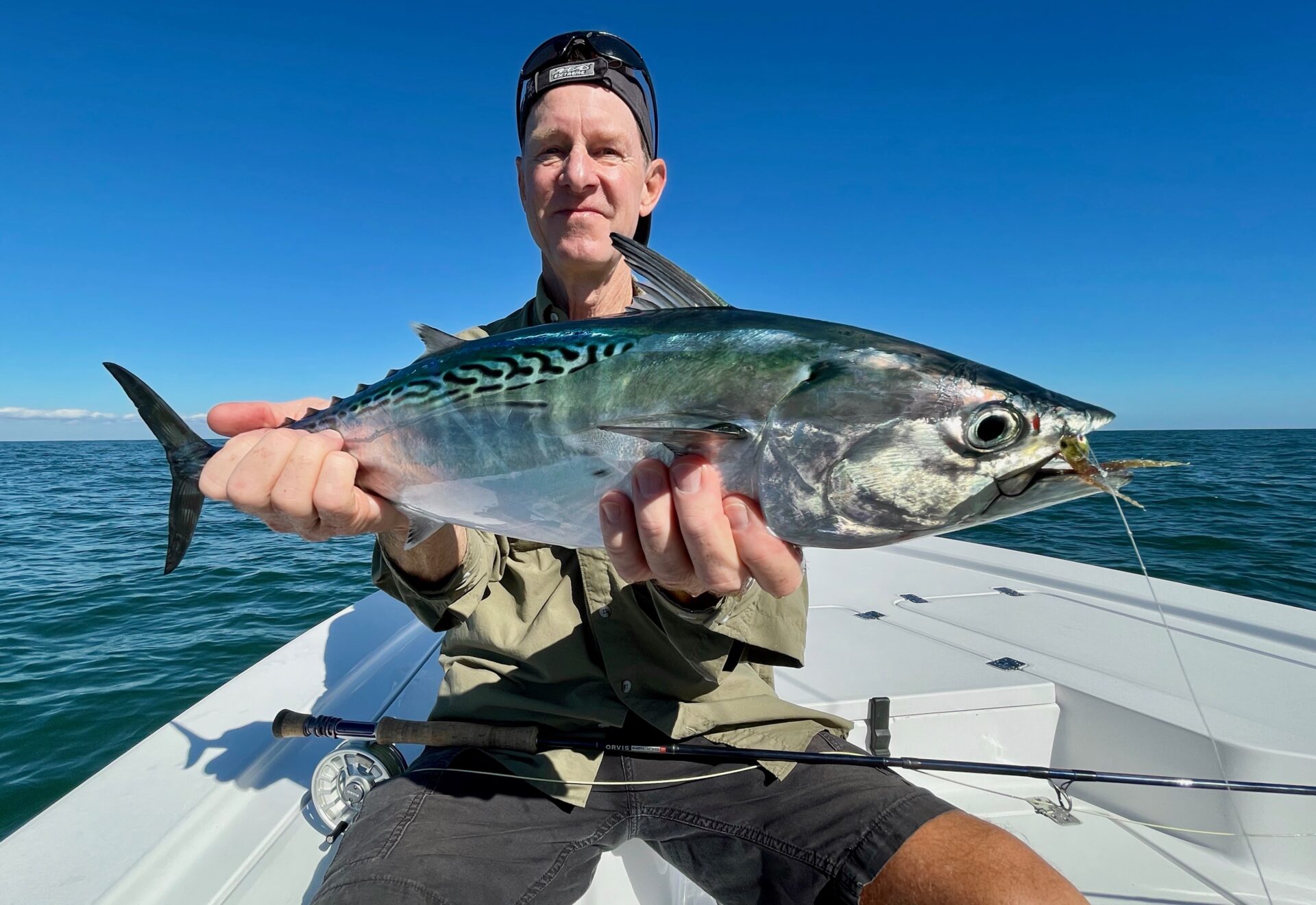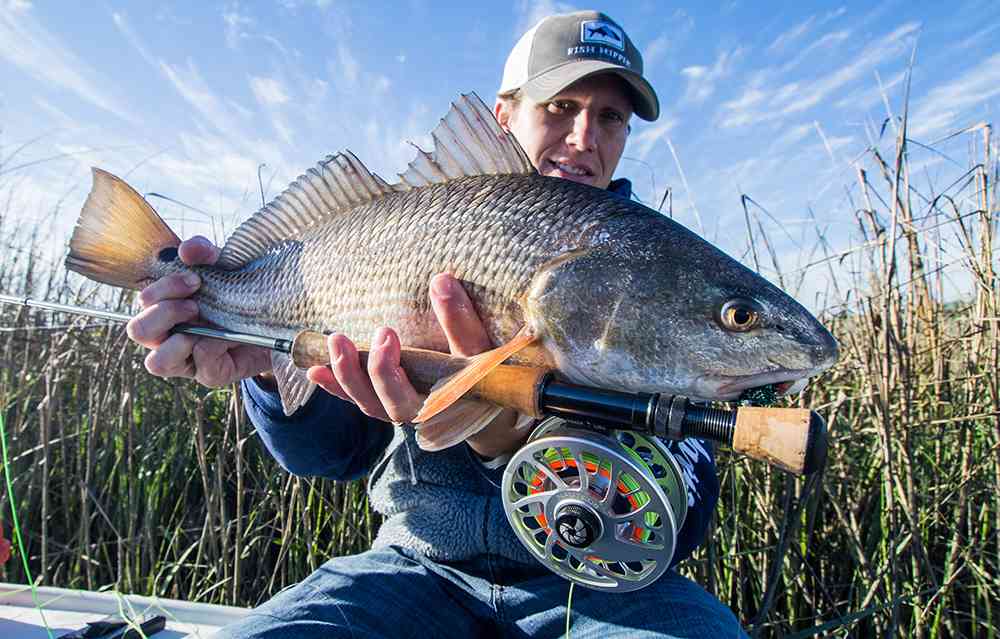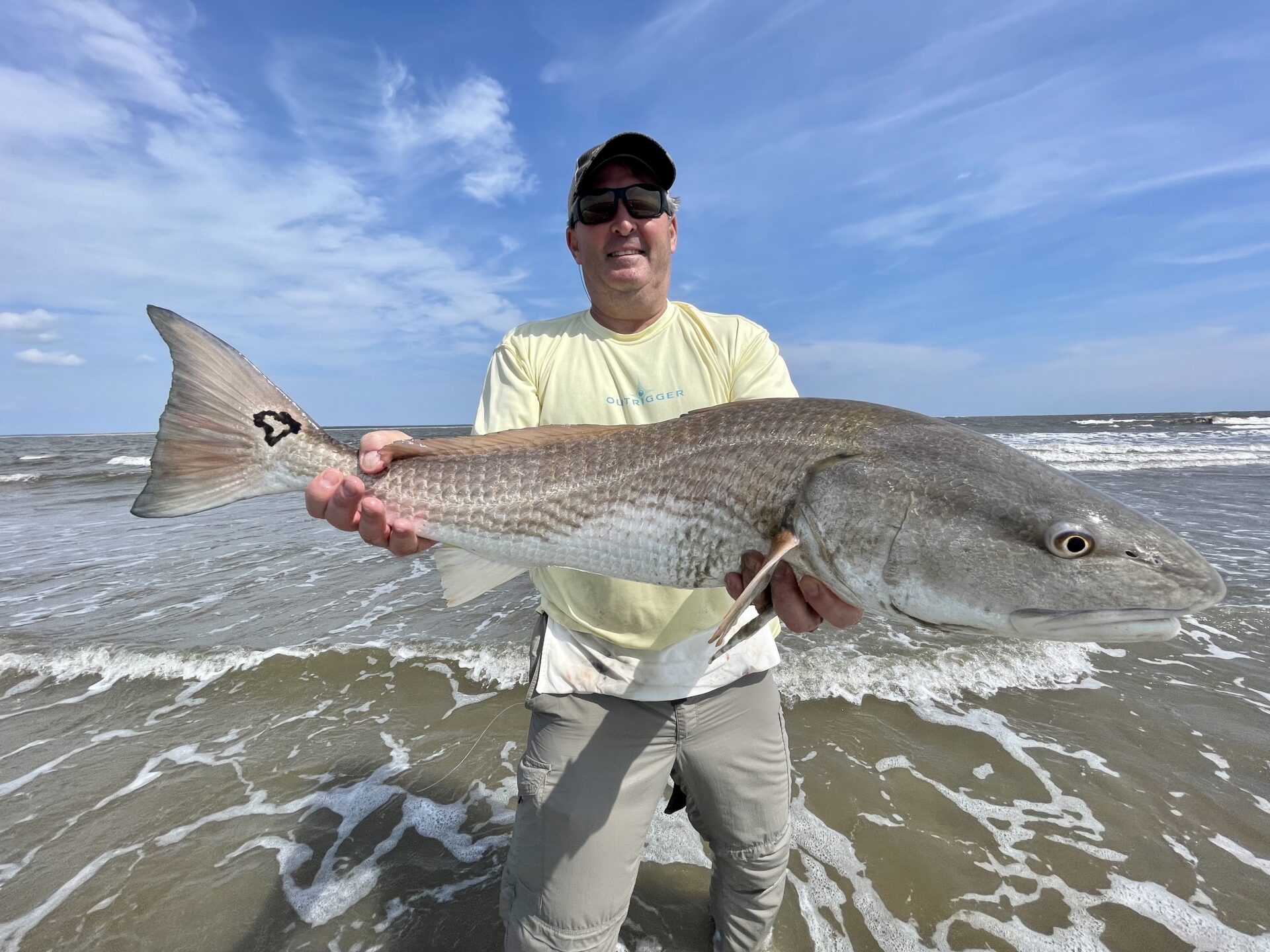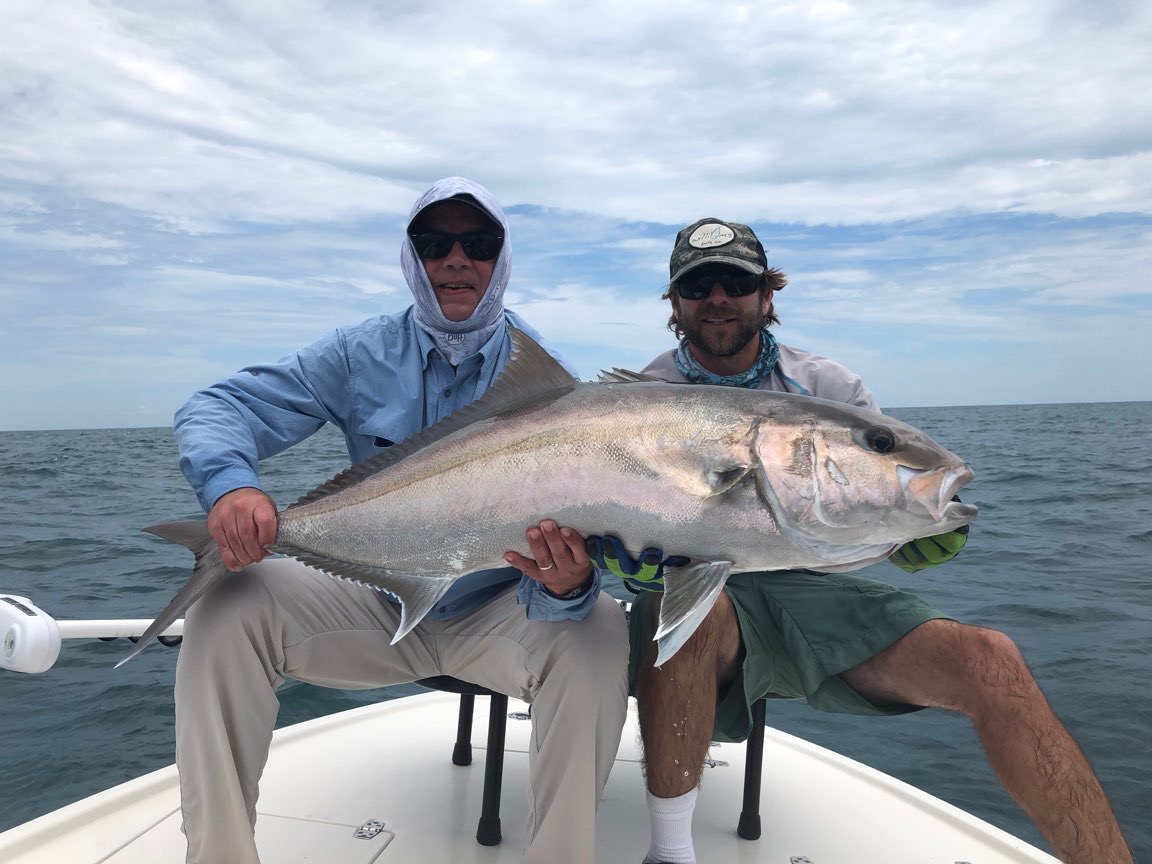Whether you’re dreaming of battling the big sharks nearshore or cruising the inshore waters for tarpon, Myrtle Beach has it all. This part of the state is South Carolina’s fishing paradise, with waters packed full of all kinds of fish just waiting to be caught.
Our deeper seas are home to marlin and tuna, while our inshore waters are perfect for catching favorites like redfish (below), flounder, and speckled trout.

You can even try your luck nearshore if you’re looking for a true ocean fishing experience with the potential for big catches, without the long boat rides.
And don’t forget about surf fishing—there’s nothing like casting from the beach and feeling that tug on the line.
No matter what kind of fishing adventures you’re after, the Grand Strand has got you covered.
Local Fish Species and Where to Catch Them
- Redfish (Sciaenops ocellatus): Found in inshore waters, especially in saltwater estuaries and lagoons. Popular spots include Georgetown, Pawleys Island, Myrtle Beach, Santee Delta, McClellanville, and Murrells Inlet. Fly fishing south of Myrtle Beach is also ideal for catching Redfish year-round.
- Tarpon (Megalops atlanticus): Common in inshore waters such as Winyah Bay, Santee Delta, and Cape Romain. Fly fishing south of Myrtle Beach is excellent for targeting tarpon, particularly in summer. Other hotspots include Georgetown, SC, and the Santee Delta.
- Black Drum (Pogonias cromis): Typically caught in inshore waters, especially in saltwater estuaries and lagoons. Surf fishing at beaches like North Island, South Island, and Cape Romain, as well as in Pawleys Island, yields good results.
- Flounder (Paralichthys dentatus): Found in inshore waters, particularly in saltwater estuaries and lagoons. Notable fishing spots include Georgetown, Pawleys Island, Myrtle Beach, Santee Delta, and Murrells Inlet.
- Speckled Trout (Cynoscion nebulosus): Common in inshore waters, especially in saltwater estuaries and lagoons. Fly fishing south of Myrtle Beach is a year-round option. Key locations include Georgetown, Pawleys Island, Myrtle Beach, Santee Delta, and McClellanville.
- King Mackerel (Scomberomorus cavalla): Located in offshore and nearshore waters, often found near reefs, wrecks, and other structures where baitfish congregate. Prominent fishing areas include Georgetown and Murrells Inlet.
- Sharks (Selachimorpha): Found in nearshore waters, particularly around inlets, jetties, and deep channels in places like Winyah Bay. Sharks are commonly found patrolling the shallows and deeper channels, drawn by the abundant fish and marine life in our area. Shark species found off the coast of Myrtle Beach include, but are not limited to:
- Blacktip Shark (Carcharhinus limbatus): Known for their acrobatic leaps and aggressive nature, Blacktip Sharks are often found in nearshore waters and estuaries. They are identifiable by the black tips on their fins and are a popular target for anglers due to their fighting spirit.
- Sandbar Shark (Carcharhinus plumbeus): Found in nearshore waters, particularly around inlets, jetties, and deep channels of Winyah Bay. Sandbar Sharks are one of the largest coastal shark species, known for their high dorsal fin and heavy body. They are typically found in sandy or muddy bottoms and are a common target for anglers due to their abundance and manageable size.
- Spinner Shark (Carcharhinus brevipinna): Similar to Blacktip Sharks but known for their spinning leaps out of the water when hooked. They are found in similar habitats and are known for their fast, erratic movements.
- Bull Shark (Carcharhinus leucas): These robust and powerful sharks are known for their ability to swim in both saltwater and freshwater. They are commonly found in nearshore waters and estuaries and are recognizable by their stocky build and blunt snout.
- Lemon Shark (Negaprion brevirostris): Typically found in shallow waters and nearshore habitats, Lemon Sharks are easily recognizable by their yellow-brown coloring and two dorsal fins of similar size. They are often found near sandy bottoms and estuaries.
- Spanish Mackerel (Scomberomorus maculatus): Targeted in fly fishing south of Myrtle Beach, Spanish Mackerel are prized for their speed and agility. They thrive in coastal waters and are often found near reefs, jetties, and piers. Known for their striking silver color and distinctive yellow spots, these fish provide an exciting challenge for anglers.
- Cobia (Rachycentron canadum): Available in fly fishing south of Myrtle Beach and in Georgetown, SC, Cobia are large, powerful fish known for their migratory patterns. They are often found near structures such as buoys, pilings, and wrecks, where they hunt for smaller fish and crustaceans. Their dark brown bodies with a white underbelly make them a distinct and desirable catch.
- False Albacore (Euthynnus alletteratus): Targeted in fly fishing south of Myrtle Beach, False Albacore, also known as Little Tunny, are part of the tuna family. They are fast swimmers often found in large schools, making them a thrilling catch. These fish are recognized by their streamlined bodies and wavy stripes along their backs.
- Sheepshead (Archosargus probatocephalus): Found in Georgetown, SC, and Myrtle Beach, Sheepshead are known for their distinctive black and white vertical stripes and human-like teeth. They are commonly found around piers, jetties, and oyster beds, where they feed on crustaceans and mollusks. Their strong jaws and fighting spirit make them a favorite among inshore anglers.
Types of Fishing Charters (Myrtle Beach)
Inshore Fishing – Great if you’re starting out or if you just want a chill day on the water with some good catches. On inshore fishing charters you’ll stay close to shore, fishing in saltwater estuaries and lagoons. It’s a hotspot for redfish, tarpon, black drum, flounder, and seatrout. It’s easier on the wallet compared to offshore trips, and it’s smoother sailing, with less chop to deal with.

Offshore Fishing – This is big game territory—marlin, tuna, and so on. Deep sea fishing is more expensive due to the longer travel times and the specialized equipment required. It typically takes several hours to reach the good fishing spots, which are far out in the open ocean. The long trip can be challenging for some, with rough waters and unpredictable weather conditions. Despite the cost and effort, the reward of landing big game fish makes it a popular choice.

Nearshore Fishing – The best of both worlds. You’re not too far from the coast of South Carolina, usually within a few miles, and it’s a great way to snag some larger species like sharks and King Mackerel without the expense or the long haul boat rides. You have a good chance at some sizable catches out here.

Tarpon Fishing (Inshore) – If you’re aiming to hook a silver king, the inshore waters south of Myrtle Beach are a gold mine. Winyah Bay, Santee Delta, and Cape Romain offer some of the best spots with minimal boat traffic, perfect for battling these acrobatic giants that can weigh anywhere from 80 to 150 pounds. While no prior experience is needed, be ready for a serious workout—tarpon fights can last over 30 minutes due to their size and strength.

Shark Fishing (Nearshore) – In Myrtle Beach, you don’t have to venture far or face choppy seas to find where the sharks hang out. They’re often right there in the calmer nearshore waters near the inlets, jetties, and deep channels of Winyah Bay. This makes for an easier (and often more productive) fishing experience, as some of the best shark fishing spots along the South Carolina coast are just a short trip from the shore. The proximity to shore means less travel time and more fishing time, making it ideal for a half-day adventure.

Fly Fishing – Just south of Myrtle lies an expansive stretch of undeveloped coastline, perfect for fly fishing enthusiasts. The primary target for fly fishermen here is Redfish, which can be caught year-round. Other species available include speckled trout, Spanish mackerel, tarpon, cobia, false albacore, sharks—and just about anything else that swims in the water that is willing to eat a fly.

Surf Fishing – We’re the only fishing charter service in Myrtle Beach offering surf fishing charters. These trips start from Georgetown, giving you access to secluded spots like North Island, South Island, and Cape Romain, with average boat rides to these fishing grounds taking about 30 to 45 minutes. Target species include Black Drum and Redfish.

Myrtle Beach Fishing Spots
Now, knowing where to fish is key. Inshore or nearshore, you might want to head a bit south to Winyah Bay. Trust me, it’s worth the short drive from Myrtle Beach. Calm waters, loads of fish—red drum, flounder, tarpon, and more.

The variety of fish you can hook here is impressive. That’s because the bay’s estuaries and shallow creeks provide perfect habitats for these species. It’s an inshore paradise.
Some other great areas to fish include:
- Georgetown, SC – Just 25 miles south of Myrtle Beach, Georgetown offers a variety of year-round fishing charters. With four rivers feeding into Winyah Bay—Pee Dee, Waccamaw, Black River, and Sampit—this area boasts a rich ecosystem. Here, you can catch red drum, speckled trout, sheepshead, flounder, tarpon, cobia, black drum, king mackerel, spadefish, and sharks. The jetties at Winyah Bay are prime spots for the big three: cobia, king mackerel, and tarpon. North Inlet is also a gem for redfish, speckled trout, and flounder, offering a secluded fishing experience. During the warmer months, tarpon migrate here, making for exciting fishing until early October.
- Pawleys Island – About 15 miles south of Myrtle Beach, Pawleys Island offers charters focused on Pawleys Creek and the surrounding beaches. Fall surf fishing here is excellent for red drum, black drum, trout, flounder, and bluefish. Pawleys Creek is accessible from both ends of the island, and flounder trolling or drifting is particularly productive in spring, summer, and fall. Other targets include red drum, trout, and black drum. Most charters depart from Georgetown, but family trips in Pawleys Creek are available, perfect for kids to fish and crab, and learn the ropes.
- Myrtle Beach – With shallow water sight fishing, saltwater fly fishing, and both inshore and nearshore charters, Myrtle Beach has it all. Year-round species include redfish, speckled trout, black drum, and sheepshead, with tarpon, sharks, cobia, and flounder making appearances in the warmer months. If you’re looking to escape the hustle and bustle of Myrtle Beach, booking a charter here gives you access to some of the best saltwater fishing in South Carolina.
- Santee Delta – The Santee Delta is a diverse estuary just a short boat ride from Georgetown, SC. It’s prime fishing territory for tarpon, speckled trout, red drum, and flounder. The fall season is fantastic for surf fishing from the barrier islands, especially when the mullet run kicks off in late August, attracting tarpon along the beaches and up the river. Year-round, you can hook red drum and speckled trout in the delta’s river system. Plus, the area is part of a Wildlife Management Area, so you might spot alligators, bald eagles, and more while you’re out there.
- McClellanville – Between Myrtle Beach and Charleston, McClellanville offers over 60 miles of untouched beaches and barrier islands. This spot sees little fishing pressure, making for excellent year-round fishing. The September mullet run sparks a tarpon feeding frenzy, and the late fall brings huge red drum to the surf. The area is also known for world-class redfishing in the flats and backwaters and thriving speckled trout populations in the Bulls Bay and Cape Romain estuaries.
- Murrells Inlet – This historic fishing village gives easy access to both inshore and nearshore fishing. Inshore, you’ll find flounder, redfish, and trout in the back creeks and around the jetties. Just a few miles offshore, the nearshore wrecks are packed with king mackerel, Spanish mackerel, flounder, sheepshead, and spadefish. It’s a great spot for a family trip—and when you’re done fishing, some of the best seafood on the East Coast is right in town.
Booking Myrtle Beach Fishing Charters

For a great adventure off the South Carolina Coast with experienced fishing guides, check out Myrtle Beach Guide Service. Whether you’re into catching redfish inshore, chasing tarpon, or even battling with sharks—we have a charter for you.
If you’re gearing up for a fishing trip to Myrtle Beach, contact us today to make a reservation.

